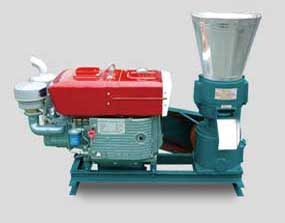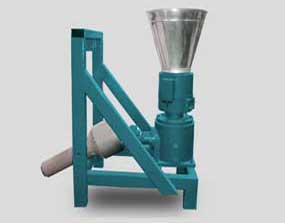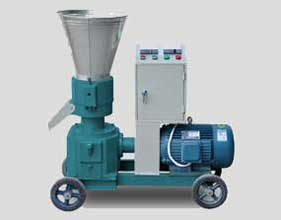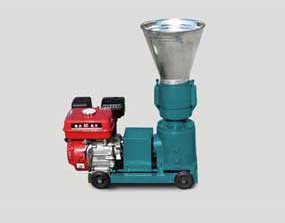Estimation of global industrial wood pellet mill market: demand and price in the future
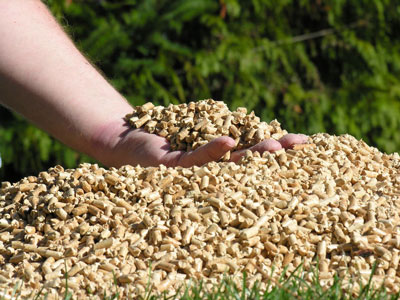 This article estimates the demand and price of industrial wood pellet mill.
This article estimates the demand and price of industrial wood pellet mill.
Demand estimation is based on the optimistic and remarkable demands of the flaming of wood pellet in large public pulverized coal power plants in Japan, Korea, America and Canada. Price estimation is based on price behavior model of industrial wood pellet. Same as all the prediction model, this one relies on using past model to predict future result and depends on assumption that influence factors of key price in the future and relations between wood pellet market demand and supply. The prediction of this article is just a guidance in the future, may not happen in the future.
The demand of industrial wood pellet
Policy that reduce carbon emission or more broadly biomass power generation drives industrial wood pellet mill market. One of the choice is substituting sustainable wood pellet with low carbon for coal in power station. Policy drives traditional markets in Europe and UK persistently and it is estimated that those markets will reach the growth peak in 2021. Then where is the demand growth in ten years? By 2030, demand in Japan may over 1000-1500 million tons per year. What if government maintains the policy of biomass power generation proportion and permits wood pellet instead of coal, as a result, the demand in Korea will become prominent as well. At the same time, if Korea keeps it, the demand may approach 800 million tons by 2024.
Canada has the potential to be the important country demands industrial wood pellet. Recently, Canada published a state carbon pricing scheme announced that the price of carbon will be 50 dollars per ton by 2023. Alberta has made laws to ban coal power generation, but now, half of electric power is from coal. Two PC power stations in Alberta are very new and some old ones will be weed out in 2030 to avoid carbon tax. While new factories will follow the example of Drax and Lynemouth in UK, making transform biomass power generation completely come true. On condition that clean energy plan could meet current challenge successfully, industrial wood pellet market will benefit from this policy. We do not include China in this analysis, if China can turn to use wood pellets for generation, the demand will be huge. By the way, if so, production in Russia may fill some demand. Sustainability and forest resources protection limit the scale of industrial wood pellet market.
Sum up with those potential and optimistic situation (excluding China), the following predictions are drawn
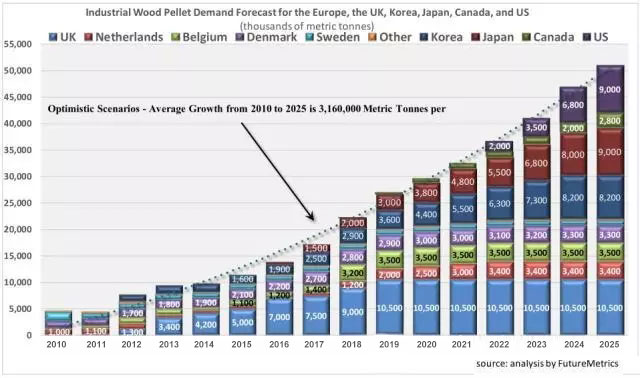
Attention please, the most potential growth comes from Japan, Korea, America and Canada after 2021. With development of these markets, the demand will reach a triple growth by 2025 and average growth will exceed 300 million tons per year from 2010 to 2025.
There are numerous reasons why these four countries can’t reach the level in image above. But as long as the policy is durable and schedulable intermittent biomass power generation is supported in place, the development of industrial wood pellet market would follow the path.
The price of industrial wood pellet
The cost of producing wood pellets for one ton is closely related with average cost of woody biomass material, while the cost of biomass material is closely related with transportation cost. It’s obviously that cost of diesel fuel drives them. Per ton cost varies from place and transport infrastructure. With time goes by, per ton cost of pellet changes with transformation of wood cost and wood’s moisture content. And the cost of wood pellet that transporting to power station depends on pellet production and transportation costs. Most industrial wood pellets are produced for specific buyer and the price of purchase contract are usually by negotiation. In other words, the price wouldn’t be so high that breaks the profit of alternator and so low that allows producer’s operation for profit. The contract currently includes items that defines the risk of currency and mechanism that adjusts price. Regulatory mechanism is a mechanism that reduces risk to alleviate the risk of producer and buyer’s changing critical input, such as wood cost and transport cost. Every pellet factory and contract have unique characteristics and different pricing arrangement.
Even now most pellets trade by bilateral contract and industrial wood pellet trade in the market are limited, but spot price actually provides information about supply- demand relationship and foreign-exchange effect. For instance, when it’s the buyer’s market, the price of spot goods is lower.
The figure below shows historical and predicted spot price in Amsterdam, Rotterdam and Antwerp per month. On account of overcapacity of industrial wood pellet market and to some extent, several warm winters control the demand of heating pellet, spot price depreciates recently. Therefore some heating pellet productions are used for industries.
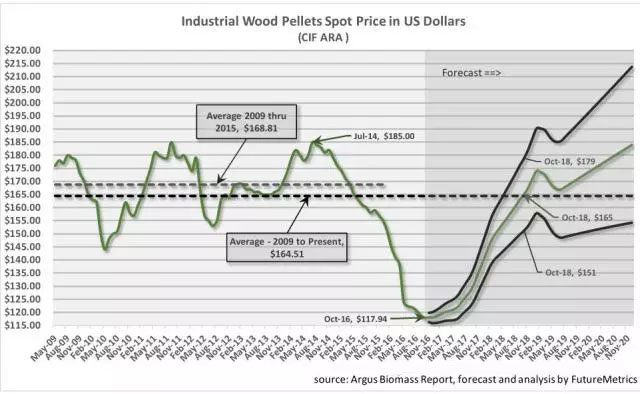
This prediction assumps that current supply-demand imbalance will be revised after several large particles consumption projects coming online and productivity won’t exceed demand while heating market consumes normal dose. By about 2019, if Lynemouth, MGT, Langerlo and Drax make burning pellets fully come true, the consumption would be 415 million tons per year. It predicted that market will go back to price that related to cost of production and variation of the exchange rate of dollar, Euro and pound will converge on PPP. In history, CIF is between 155 and 175 dollar. It still hypothesizes that inflation rate is 15% per year and shipping rate will increase to 2.0% from now on in 2020.
Demand of wood pellet mill will increase
Wood pellets have good prospects, so does wood pellet mills. They are made of high quality raw materials so that the pelletizing service time is longer and make wood pellet brilliant enough to burn sufficiently. What’s more, you could get a wide range of raw materials such as waste wood, tree branches, wood chips, sawdust, etc, each of which is easy to save manpower and money from the beginning. The most important is that those biomass resources used to make wood pellets make a contribution to the protection of forests and tree resources, which are in a serious current situation.
Do you have a large amount of waste biomass materials that has been discarded before? Do you want to capture this potential investment opportunity? Get in touch with us, we will help you change waste into wealth! We are ready to meet you!


